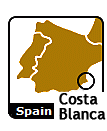Calpe
Calpe, the artist's town. An oasis in the most popular tourist region of the Costa Blanca.Calpe is the town of connoisseurs, the town chosen by the whole of Europe as its summer retreat. A privileged enclave beside the calm blue waters of the Mediterranean, where outstanding natural beauty, gastronomy, culture, the sea and the mountains are part of the everyday life of its inhabitants all year round. There are Museums, picturesque little streets and squares and many bars and restaurants, most of them with a lively outside terrace, an ideal place to spend a pleasant summer evening. Calpe will surprise you with its daring contrasts, where modern buildings and wide avenues harmonize with an ancient fishing village, where locals are proud of their past, yet welcome tourists and visitors with warm-hearted hospitality.
Calpe is a town which is full of history and culture. Its strategic location on the coast has attracted many voyagers and settlers throughout history. Remains of Iberian tribes were discovered around the Rock of Ifach. Later, the Romans founded a prosperous colony on the coastal plain whose main activity was commerce in dried, salted fish. During the Medieval period, the farming population was spread out in a number of independent settlements. Christians and Moors lived peacefully for a time, but the local population suffered continual attacks by pirates during the 14th to the 17th centuries. Calpe entered a period of redevelopment during the 18th century, consolidating the town in the 19th century and laying the foundations for its current prosperity as a major attraction for both national and international tourism. In the ancient town center, next to the Moorish quarter (Arrabal) there is a group of monuments comprising the Torreo de la Peça, the Town Walls and the church known as the Iglesia Vieja, the sole surviving example of Mudejar-Gothic architecture in the province of Valencia. Along the coast, there is the Moli Tower and the remains of an ancient Roman salted fish industry which have only just recently been found.
Calpe facts and figures:
* Inhabitants: 13,000
* Access: Motorway A7 exits 63 and 64. National N332 Valencia, Calpe, Alicante, Altea - Alicante. Alicante airport "El Altet" 70km. Railway "Trenet de la Marina" Denia - Alicante.
* Nature: The Peñon de Ifach (Rock of Ifach) nature reserve. If you're feeling fit there's a path to the summit. The Salinas: A natural salt lake with Flamingos and Herons.
* Restaurants: 168 including traditional Valencia, Calpe, Alicante, Altean (typical dishes - "Cruet de Peix", "Putxero amb Pilotes", "Fideua"), Greek, Lebanese, Dutch, German, Indian, Chinese etc.
* Sports: Sailing - Calpe yacht harbour. Max. 5m.
Golf - Golf Don Cayo. Panoramic views of the mediterranean. 3078m, 9 holes, par 36. Urbanizacion Sierra de Altea. Club de Golf Ifach. Panoramic sea views from the clubhouse. 3406m, 9 holes, par 60. Urbanizacion San Jaime.
Tennis - Calpe Tennis Club. 6 clay courts open to the public. Altea Hills Tennis Club. 4 clay courts open to the public.
Mountain Walking - The "Costa Blanca Mountain Walkers". Twice a week with an easier walk on Saturday.
Scuba diving - Puerto Blanca harbour. Urbanizacion Maryvilla. Specialist shop and diving club. Basetes harbour.
* Fiesta calendar: January 5th - The Three Kings. The children receive their presents from the three kings at the Plaza Colon.
March 19th - "Fallas" Giant papier-mache statues on satirical themes that are ceremonially burnt.
June 24th - "San Juan" Hogueras de San Juan. Chapel of La Cometa.
July 16th - "Fiesta de Carmen" in honour of the Virgin and in remembrance of fishermen lost at sea.
August 5th - "Virgen de las Nieves". A centurys old fiesta with an impressive firework display. Offering flowers to the Virgin.
October 9th - German Beer Festival. Beer and music with German bands.
End October - "Moors and Christians" in honour of the "Santisimo Cristo del Sudor" patron saint of Calpe since 1682. Starts with an invasion of the beach by the Moors. Defense of the town by the Christians with a gun battle. The locals are members of Christian or Moorish clubs "filas" eg. Almogávares, Almorávides", "Templaris" and dress up accordingly. Spectacular firework display and parade.
* History: Calpe has been inhabited since the earliest times and until recently has made its living from fishing and almond and olive crops. It occupies a strategic position on the coast (the Peñon and Mascarat pass). B.C.: Neolithic, Iberians, Phoenicians, Carthaginians. A.D.: Romans, Visigoths, Arabs/Moorish until the 1254 Christian re conquest by Jaime of Aragon. The coast was attacked by North African pirates until the 17th century, accounting for the town walls and watchtower.
Attraction of Calpe and what to do

 Calpe is known as the artists’ town and is a most popular tourist destination on the Costa Blanca. You’ll find it most picturesque with quaint little streets and squares and many bars and restaurants, most of them with a lively outside terrace: an ideal place to spend a pleasant summer evening. Calpe will surprise you with its daring contrasts, where modern buildings and wide avenues harmonizing with an ancient fishing village, where locals are proud of their past, yet welcome tourists and visitors with warm-hearted hospitality.
Calpe is known as the artists’ town and is a most popular tourist destination on the Costa Blanca. You’ll find it most picturesque with quaint little streets and squares and many bars and restaurants, most of them with a lively outside terrace: an ideal place to spend a pleasant summer evening. Calpe will surprise you with its daring contrasts, where modern buildings and wide avenues harmonizing with an ancient fishing village, where locals are proud of their past, yet welcome tourists and visitors with warm-hearted hospitality.
The town is full of history and culture. Its strategic location on the coast has attracted many voyagers and settlers throughout history. Remains of Iberian tribes were discovered around the Rock of Ifach. Later, the Romans founded a prosperous colony on the coastal plain whose main activity was commerce in dried, salted fish. During the Medieval period, the farming population was spread out in a number of independent settlements. Christians and Moors lived peacefully for a time, but the local population suffered continual attacks by pirates during the 14th to the 17th centuries. Calpe entered a period of redevelopment during the 18th century, consolidating the town in the 19th century and laying the foundations for its current prosperity as a major attraction for both national and international tourism.
What to do
1. In the ancient town centre, next to the Moorish quarter (Arrabal) there is a group of monuments comprising the Torreo de la Peça, the Town Walls and the church known as the Iglesia Vieja, the sole surviving example of Mudejar-Gothic architecture in the province of Valencia. Along the coast, there is the Moli (tower) and the remains of an ancient Roman salted fish industry that was recently discovered. In the ancient town centre, next to the Moorish quarter (Arrabal) there is a group of monuments comprising the Torreo de la Peça, the Town Walls and the church known as the Iglesia Vieja, the sole surviving example of Mudejar-Gothic architecture in the province of Valencia. Along the coast, there is the Moli (tower) and the remains of an ancient Roman salted fish industry that was recently discovered. |
 2. The Peñon de Ifach (Rock of Ifach), otherwise known as the northern rock in comparison to the southern rock we know as Gibralter, is a nature reserve. The limestone outcrop emerges from the sea to a height of 332 mts and linked to the shore by rock debris. It’s home to numerous rare plants, including a number of endemic species, over 300 species of animals and a nesting site for colonies of sea birds and other birds. Whilst it is very popular with mountain climbers, there is a very safe pathway that leads you to the top for the regular tourist. Allow 1.5 hours to get to the top, so you’ll need to take some refreshments and the all important suncream and floppy hat. At the base there is a Roman archeological dig exposing a walled enclave. 2. The Peñon de Ifach (Rock of Ifach), otherwise known as the northern rock in comparison to the southern rock we know as Gibralter, is a nature reserve. The limestone outcrop emerges from the sea to a height of 332 mts and linked to the shore by rock debris. It’s home to numerous rare plants, including a number of endemic species, over 300 species of animals and a nesting site for colonies of sea birds and other birds. Whilst it is very popular with mountain climbers, there is a very safe pathway that leads you to the top for the regular tourist. Allow 1.5 hours to get to the top, so you’ll need to take some refreshments and the all important suncream and floppy hat. At the base there is a Roman archeological dig exposing a walled enclave. |
 3. The beaches, as you would expect on the Costa Blanca, are white sand and stretch long distances. The principle one being the Arenal-Bol Beach is located at the foot of the Rock of Ifach. It is made up of fine sand, clear water and equipped with services. It was awarded the blue flag in 2008 and it stretches approx. 1,400 metres with an average width of 60 metres. A fully equipped beach to enjoy the sun and the Mediterranean Sea with the family. The Cantal Roig Beach is another of Calpe’s beaches that also has a Blue Flag, but just 200 mts long. It is next to the port and the Rock of Ifach. Expect to find it also well equipped with deckchairs, toilets, walkways, a lifeguard service and foot showers. The Levante or La Fossa Beach is a very popular beach in Calpe, located on the northern side of the Rock of Ifach, which fronts the tall hotel and apartment buildings. It stretches for some 950 metres and is the best equipped beach in Calpe with walkway, children’s park, motorized rental, beach umbrellas and deckchairs, foot showers, lifeguard service, toilets and showers, changing rooms and a sports area. 3. The beaches, as you would expect on the Costa Blanca, are white sand and stretch long distances. The principle one being the Arenal-Bol Beach is located at the foot of the Rock of Ifach. It is made up of fine sand, clear water and equipped with services. It was awarded the blue flag in 2008 and it stretches approx. 1,400 metres with an average width of 60 metres. A fully equipped beach to enjoy the sun and the Mediterranean Sea with the family. The Cantal Roig Beach is another of Calpe’s beaches that also has a Blue Flag, but just 200 mts long. It is next to the port and the Rock of Ifach. Expect to find it also well equipped with deckchairs, toilets, walkways, a lifeguard service and foot showers. The Levante or La Fossa Beach is a very popular beach in Calpe, located on the northern side of the Rock of Ifach, which fronts the tall hotel and apartment buildings. It stretches for some 950 metres and is the best equipped beach in Calpe with walkway, children’s park, motorized rental, beach umbrellas and deckchairs, foot showers, lifeguard service, toilets and showers, changing rooms and a sports area. |
 4. The Salinas is a natural salt lake with Flamingos and Herons, which is located parallel to the Levante and Fossa Beach. Unless you are a keen bird watcher, then simply stop by when travelling through Calpe. 4. The Salinas is a natural salt lake with Flamingos and Herons, which is located parallel to the Levante and Fossa Beach. Unless you are a keen bird watcher, then simply stop by when travelling through Calpe. |
  5. Moors and Christians Fiesta in honour of the "Santisimo Cristo del Sudor" patron saint of Calpe since 1682 is not to be missed. Starts with an invasion of the beach by the Moors. Defence of the town by the Christians with a gun battle. The locals are members of Christian or Moorish clubs "filas" eg. Almogávares, Almorávides or Templaris and dress up accordingly, then march down the streets. 5. Moors and Christians Fiesta in honour of the "Santisimo Cristo del Sudor" patron saint of Calpe since 1682 is not to be missed. Starts with an invasion of the beach by the Moors. Defence of the town by the Christians with a gun battle. The locals are members of Christian or Moorish clubs "filas" eg. Almogávares, Almorávides or Templaris and dress up accordingly, then march down the streets.The ubiquitous spectacular firework display and parade occurs at the end of October each year, so one to take note of. Other fiesta include the following; January 5th - The Three Kings. The children receive their presents from the three kings at the Plaza Colon. March 19th - "Fallas" Giant papier-mache statues on satirical themes that are ceremonially burnt. June 24th - "San Juan" Hogueras de San Juan. Chapel of La Cometa. July 16th - "Fiesta de Carmen" in honour of the Virgin and in remembrance of fishermen lost at sea. August 5th - "Virgen de las Nieves". A century’s old fiesta with an impressive firework display. Offering flowers to the Virgin. |
6 . For golf lovers the Don Cayo is close by with panoramic views of the Mediterranean. It’s a 3078m, 9 holes, par 36. In addition there is the Club de Golf Ifach, which also give you panoramic sea views from the clubhouse. Urbanizacion San Jaime. For tennis lovers there is the Calpe Tennis Club. 6 clay courts open to the public, as well as the Altea Hills Tennis Club with 4 clay courts open to the public too. Other sports activities include sailing at the yacht harbour, scuba diving and snorkeling. . For golf lovers the Don Cayo is close by with panoramic views of the Mediterranean. It’s a 3078m, 9 holes, par 36. In addition there is the Club de Golf Ifach, which also give you panoramic sea views from the clubhouse. Urbanizacion San Jaime. For tennis lovers there is the Calpe Tennis Club. 6 clay courts open to the public, as well as the Altea Hills Tennis Club with 4 clay courts open to the public too. Other sports activities include sailing at the yacht harbour, scuba diving and snorkeling. |
 7. If you venture out with a small boat or kayak then you can gain access to the ordinarily inaccessible coves that are ideal for fishing and diving such as the Collao Cove or Racó del Corb and the Gasparet Cove. For diving enthusiast the The Racó Cove is accessible by foot through the Prince of Asturias’ Ecological Promenade, at the foot of the Rock of Ifach. It is well equipped with watch guard and rescue service, as well as toilets. Other accessible coves include the Manzanera Cove, which is some 200 meters wide, is made up of stones and boulders, Les Urques Cove is located south of the Calpe coast, close to Puerto Blanco and to the Puerto Blanco beach, the Morelló Cove is located next to the Arenal-Bol beach on the Infanta Elena Seafront. It is a small cove extending approx. 50 metres. The Penyal Cove is accessible by foot through a small path located on the northern side of the Rock of Ifach. The Cabalga Cove is next to La Fossa beach and stretches approx. 100 metres of rounded stones or boulders. It is equipped with bins, toilets, foot showers and has a lifeguard service. Finally the Mallorquí Cove is very close to the Les Basetes Sailing Club. However, it is a small cove though popular with divers. 7. If you venture out with a small boat or kayak then you can gain access to the ordinarily inaccessible coves that are ideal for fishing and diving such as the Collao Cove or Racó del Corb and the Gasparet Cove. For diving enthusiast the The Racó Cove is accessible by foot through the Prince of Asturias’ Ecological Promenade, at the foot of the Rock of Ifach. It is well equipped with watch guard and rescue service, as well as toilets. Other accessible coves include the Manzanera Cove, which is some 200 meters wide, is made up of stones and boulders, Les Urques Cove is located south of the Calpe coast, close to Puerto Blanco and to the Puerto Blanco beach, the Morelló Cove is located next to the Arenal-Bol beach on the Infanta Elena Seafront. It is a small cove extending approx. 50 metres. The Penyal Cove is accessible by foot through a small path located on the northern side of the Rock of Ifach. The Cabalga Cove is next to La Fossa beach and stretches approx. 100 metres of rounded stones or boulders. It is equipped with bins, toilets, foot showers and has a lifeguard service. Finally the Mallorquí Cove is very close to the Les Basetes Sailing Club. However, it is a small cove though popular with divers. |
 8. One excursion you might wish to undertake is a day trip to Benidorm by car, or take a boat from Calpe marina that’s located alongside the old fishing port. 8. One excursion you might wish to undertake is a day trip to Benidorm by car, or take a boat from Calpe marina that’s located alongside the old fishing port. |
This Blog gives you some helpful information about a wine tour trip from Calpe.
We have compiled a simple list of useful Spanish words and phrases that may be of help to you when sightseeing, dining out, shopping etc. Please visit Learn Spanish







